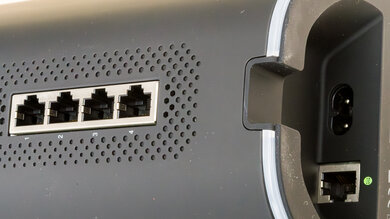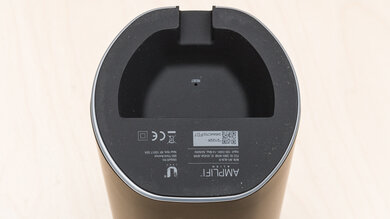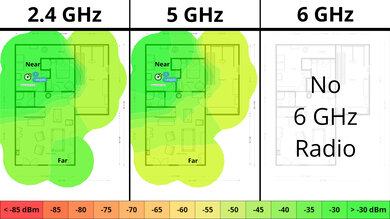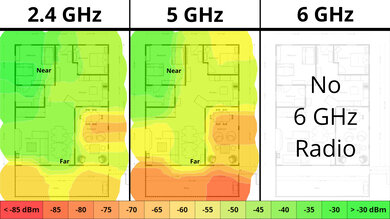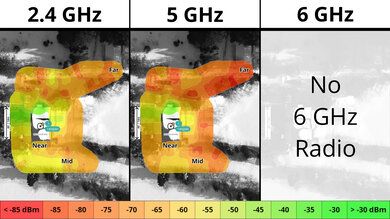The AmpliFi Alien is a tri-band Wi-Fi 6 router in Ubiquiti's AmpliFi consumer router lineup. It has a 2.4GHz band and two 5GHz bands. It features a 4.7-inch touchscreen that displays the network status and allows you to change various settings. The router also has a light ring on the bottom that shines green and flashes when you change settings. It's available as a standalone router or in a multi-pack with the Alien MeshPoint, an access point that allows you to configure a mesh network. We bought and tested it as a standalone router.
Our Verdict
The AmpliFi Alien router is very good if you live in an apartment, condo, or single-story home. It provides fast speeds that are suitable for downloading large files quickly or handling multiple users streaming 4k content simultaneously. It doesn't have multi-gigabit networking, so you can't achieve local speeds faster than 1Gbps. It has a touchscreen on the front that allows you to monitor the router and adjust various settings. While it's on the larger side, it has a simple cylindrical design without any external antennas, making it easy to place in your living space.
-
Great top speeds.
-
Functional touchscreen and interesting design.
-
Wi-Fi 6 won't take full advantage of new Wi-Fi 6E or 7 devices.
The AmpliFi Alien is a great router if you live in a multi-story home. It provides impressive speeds over long distances that are suitable for high-bandwidth uses, like downloading large game updates quickly and multiple 4k video streams at the same time. While we tested it as a standalone router, it's also available in a mesh kit for even better coverage. Design-wise, it has a touchscreen on the front that allows you to monitor the router and change various settings. Despite being on the larger side, its simple cylindrical design, without any external antennas, makes it easy to place in your home.
-
Great top speeds.
-
Functional touchscreen and interesting design.
-
Impressive range.
-
Available as a mesh kit to further improve range.
-
Wi-Fi 6 won't take full advantage of new Wi-Fi 6E or 7 devices.
The AmpliFi Alien delivers great speeds and is suitable for an internet connection of up to ~750Mbps. It also supports DFS (Dynamic Frequency Selection), so it can use less congested DFS-only channels to give you better speeds in noisy wireless environments. That said, it's only Wi-Fi 6, so it doesn't have a faster 6GHz band for your Wi-Fi 6E or 7 devices to take advantage of.
-
Great top speeds.
-
Functional touchscreen and interesting design.
-
Wi-Fi 6 won't take full advantage of new Wi-Fi 6E or 7 devices.
We tested the AmpliFi Alien as a standalone router, but it's also available in a kit with additional access points. That said, even in standalone mode, it has impressive range and maintains fast speeds over a long distance.
-
Functional touchscreen and interesting design.
-
Impressive range.
-
Available as a mesh kit to further improve range.
-
Wi-Fi 6 won't take full advantage of new Wi-Fi 6E or 7 devices.
Changelog
-
Updated Jan 23, 2025:
We've added a link to the newly reviewed UniFi Dream Router in the Network Ports section.
- Updated Jul 22, 2024: Review published.
Check Price
Differences Between Sizes And Variants
The AmpliFi Alien is available as a standalone router or in a multi-pack with either another router or the Alien Meshpoint, a mesh access point with only one Ethernet port and no external screen. We bought and tested the standalone router. You can see the label of our unit here.
Compared To Other Routers
The AmpliFi Alien router is a tri-band Wi-Fi 6 router with a 2.4GHz band and two 5GHz bands. It has a unique design with a 4.7-inch touchscreen that allows you to monitor the network and change various settings. It supports mesh networking with other Alien routers or Alien MeshPoints and is available in a multi-pack.
This router delivers great top speeds and very impressive range in standalone mode, which is even better than some mesh systems in its class, like the TP-Link Deco X5000 and eero Pro 6. That said, it's only Wi-Fi 6, and other routers in the same price category, like the TP-Link Deco XE5300 and the TP-Link Archer BE550, support Wi-Fi 6E and Wi-Fi 7, respectively.
If you're looking for more options, check out our recommendations for the best Wi-Fi routers, the best Wi-Fi 6 routers, and the best long-range Wi-Fi routers.
The AmpliFi Alien and the UniFi Dream Router are Wi-Fi 6 routers from two of Ubiquiti's product lines. The AmpliFi is a tri-band router that delivers better speed and range than the UniFi. The UniFi, on the other hand, has a much more robust and configurable feature set that's better suited for advanced users. If you value performance and convenience, the AmpliFi is the better pick, but if you prefer in-depth configuration and options for expanding your network, the UniFi is the better choice.
Test Results
The depth with cables measurement is taken with the power cable and the WAN cable plugged in, and the WAN and power ports are recessed at the bottom. If you have a LAN cable plugged in, the depth is 5.79 inches (14.7 cm).
If you're looking for a router with PoE (Power over Ethernet) ports, check out the UniFi Dream Router.
We bought a single unit of this router and tested it in standalone mode, so the mesh satellite position line on this graph isn't applicable.
We bought a single unit of this router and tested it in standalone mode, so the mesh satellite position line on this graph isn't applicable.
Comments
AmpliFi Alien: Main Discussion
Let us know why you want us to review the product here, or encourage others to vote for this product.
- 21010
LOL….yes, well you did it. You rated the LG “magic remote” higher than the excellent, well thought-out Sony remote. The LG remote continues to be the same stinker that people universally pan. Numbers? NUMBERS? Who uses numbers on their LG remote? Meanwhile, Sony has backlit AND touch-sensitive, without cluttering the face with worthless numbers. It is accurate as compared to the LG “pointer” which continues to amaze people. Oh, and Sony even integrated a “finder” mechanism! Wonderful. Love you Rtings in general + measurements, but ask a broader number of people about these two remotes, because I am confident that you will not get a “9.0” result from the “LG Magic remote.” Thanks !
Edited 1 year ago: Forgot to add



